 Globalisation has led to an increasingly interdependent world, with companies based in one country often dependent on a market abroad. In recent years, it is the rapid growth of countries like China that has led to growth in the size of the markets for many products. With incomes rising in emerging countries, demand for many products has been growing, but in the past year, the trend for Prada has ended and seems to be reversing.
Globalisation has led to an increasingly interdependent world, with companies based in one country often dependent on a market abroad. In recent years, it is the rapid growth of countries like China that has led to growth in the size of the markets for many products. With incomes rising in emerging countries, demand for many products has been growing, but in the past year, the trend for Prada has ended and seems to be reversing.
As the market in China matures and growth of demand in Europe slows, Prada has seen its shares fall by the largest margin since June last year.
Prada is a well-known luxury brand. The products it sells are relatively expensive and hence its products are likely to have an income elasticity of demand well above +1. With changes in China and Europe, Prada expects its growth in sales to January 2015 will be ‘low single-digit’ – less than the 7% figure recorded for the last financial year.
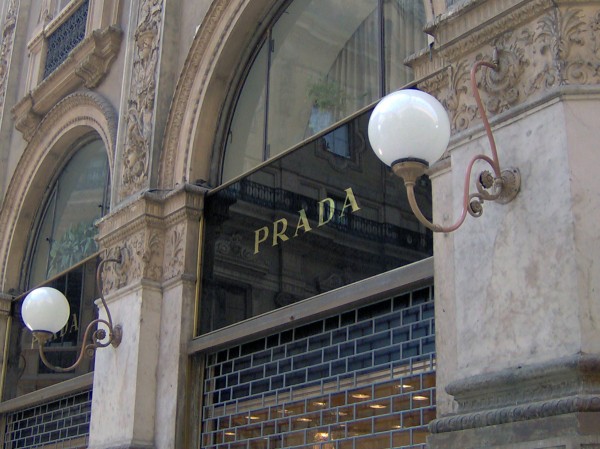 This lower growth in same-store sales is likely to continue the following year as well. Add on to this the lower-than-expected profits, which missed analysts’ forecasts, and you have a prime example of a brand that is suffering because of its customer base and the economic times.
This lower growth in same-store sales is likely to continue the following year as well. Add on to this the lower-than-expected profits, which missed analysts’ forecasts, and you have a prime example of a brand that is suffering because of its customer base and the economic times.
Prada isn’t alone in suffering from economic conditions and, relative to its European counterparts, is expected to have higher growth in sales and profits in the next 12 months – at 11.5% and 14.8% respectively. This is according to a survey by Thomson Reuters.
 Prada has exploited high demand by Chinese consumers, but has recently been affected by the strength of the euro. A strong euro means that the Italian-based Prada is struggling with exports, which only adds to its problems. As economic growth picks up in China and as other emerging economies begin to experience more rapid economic growth, the fortunes of this luxury-retailer may change once more. However, with volatile economic times still around in many countries, the future of many retailers selling high-end products to higher income customers will remain uncertain. The following articles consider the fortunes of Prada.
Prada has exploited high demand by Chinese consumers, but has recently been affected by the strength of the euro. A strong euro means that the Italian-based Prada is struggling with exports, which only adds to its problems. As economic growth picks up in China and as other emerging economies begin to experience more rapid economic growth, the fortunes of this luxury-retailer may change once more. However, with volatile economic times still around in many countries, the future of many retailers selling high-end products to higher income customers will remain uncertain. The following articles consider the fortunes of Prada.
Prada shares fall sharply after China luxury warning BBC News (3/4/14)
Prada falls after forecasting slowing luxury sales growth Bloomberg, Andrew Roberts and Vinicy Chan (3/4/14)
Prada profits squeezed by weakness in Europe and crackdown in China The Guardian (2/4/14)
Prada bets on men to accelerate sales growth Reuters, Isla Binnie (2/4/14)
Prada misses full year profit forecast Independent, Laura Chesters (2/4/14)
Questions
- How can we define a luxury product?
- Explain the main factors which have led to a decline in the demand for Prada products over the past 12 months.
- Using a diagram, illustrate what is meant by a strong euro and how this affects export demand.
- What business strategies are Prada expected to adopt to reverse their fortunes?
- Using a diagram, explain the factors that have caused Prada share prices to decline.
 The housing market is often a good indicator of the level of confidence in an economy. Prior to the credit crunch, there had been a house price bubble and as the financial crisis began and economies plunged into recession, house prices began to fall significantly. In the last few months, the housing market has begun its recovery and data from the ONS shows average property prices up by 5.4% across the UK in November, compared with a year earlier.
The housing market is often a good indicator of the level of confidence in an economy. Prior to the credit crunch, there had been a house price bubble and as the financial crisis began and economies plunged into recession, house prices began to fall significantly. In the last few months, the housing market has begun its recovery and data from the ONS shows average property prices up by 5.4% across the UK in November, compared with a year earlier.
When we analyse the housing market, or any market, we have to give attention to both demand-side and supply-side factors. It is the combination of these factors that yields the equilibrium price. For most people, buying a house will represent their single biggest expenditure and so there are many factors that need to be considered.
The demand for housing is affected by incomes, by the availability of mortgages, the rate of interest and hence the cost of mortgages. Speculation also tends to be a key factor that influences the demand for houses, as people may buy houses if they believe that prices will soon rise. Of course, simply by responding to expectations about future price changes causes the price changes to happen – a classic case of self-fulfilling speculation.
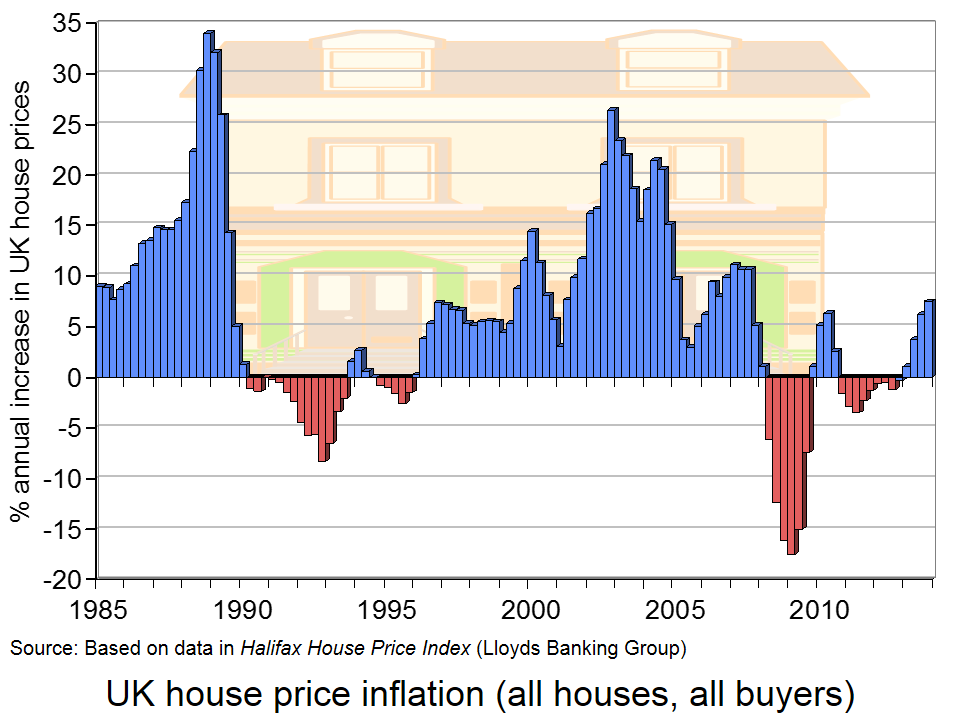 The availability of mortgages has been one of the biggest factors increasing the demand for and hence price of houses in recent months. More individuals have been able to get onto the property ladder and, with confidence returning to the market, these factors have caused a rightward shift in the demand for owner-occupied houses.
The availability of mortgages has been one of the biggest factors increasing the demand for and hence price of houses in recent months. More individuals have been able to get onto the property ladder and, with confidence returning to the market, these factors have caused a rightward shift in the demand for owner-occupied houses.
Another key factor has been the growth in the demand for housing as an investment opportunity, in particular from the global super rich. This has been of particular concern in London, where there are fears of a housing bubble developing and of lower-income households being priced out of the market.
At the same time, there has been a growth in the supply or housing and thus a rightward shift of the supply curve. Ceteris paribus, this would push down average prices. However, the data suggest that house prices, especially in London, have increased, implying that the impact on price of the increase in demand has more than offset the downward force in prices from the increase in supply. Part of this can be explained by the demand-side factor of an increase in demand for top-end properties, which ‘has been distracting developers from the need for more affordable accommodation.’ When asked about the changes observed in the London housing market, Civitas said:
London is one of the most – if not the most – attractive property markets for international investors all over the world. It is also at the centre of an affordability crisis in the UK which is having serious consequences for younger people and the less well-off…For too many it [investment at the top end of the market] is providing financial shelter rather than human shelter.
With the upward pressure on house prices, many are now warning of another bubble developing in London. When comparing house prices in London with a Londoner’s income, Ernst and Young found that house prices were 11 times average annual income. Data like this were last seen prior to the financial crisis and it is this which has led to concerns of a post-crisis bubble.
There are suggestions that more action is needed to combat this bubble, such as imposing a limit in income multiples in relation to how much of a mortgage you are able to borrow. Another criticism levelled at the market is the government’s Help to Buy scheme, which critics argue is raising demand and pushing up prices, because there is no matched increase in supply.
So, with the rest of the market returning to some semblance of normality, it is currently just London showing signs of a bubble and we are all well aware of what the consequences might be if a bubble is allowed to grow and then eventually burst. The following articles consider the housing market.
Housing bubble forming in London, warns Ernst and Young BBC News (3/2/14)
London housing market shows new bubble sign – report Reuters, Andrew Winning (3/2/14)
Expert calls for stronger action to tame London housing bubble risks Independent (21/5/12)
London shows signs of house price ‘bubble’, experts warn The Telegraph, Scott Campbell (3/2/14)
Economic forecasters call for measures to cool down London’s property market The Guardian, Rupert Neate (3/2/14)
Think-tank calls for a ban on rich foreigners buying homes in London to puncture property bubble Mail Online, Lizzie Edmonds (2/2/14)
London property bubble to last until 2018 Sky News (3/2/14)
Questions
- What are the key factors that will affect (a) the demand for and (b) the supply of housing?
- Which factors explain why house prices in London have increased relative to prices across the country? Identify which factors are demand-side and which are supply-side.
- How has Help to Buy affected the housing market?
- What government policies could be implemented to ‘puncture’ the bubble?
- Why is a housing bubble a problem?
- Why has a house price bubble not emerged in the rest of the UK?
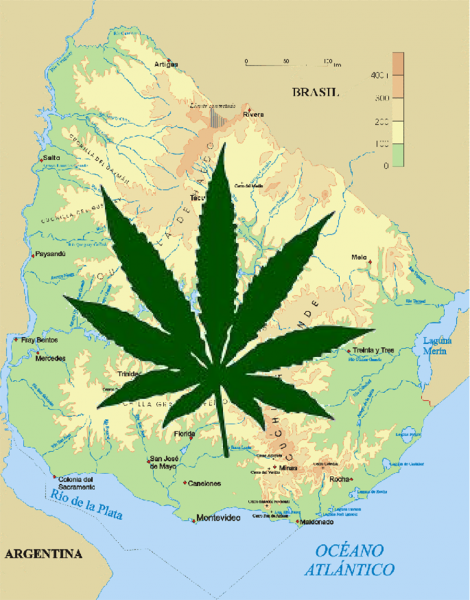 In December 2013, Uruguay passed a law permitting the growing, distribution and consumption of marijuana. The legislation comes into effect in April 2014. The state will regulate the industry to ensure good quality strains of the crop are grown and sold. It will also tax the industry.
In December 2013, Uruguay passed a law permitting the growing, distribution and consumption of marijuana. The legislation comes into effect in April 2014. The state will regulate the industry to ensure good quality strains of the crop are grown and sold. It will also tax the industry.
Uruguay is the first country to legalise cannabis, but in July 2012, Colorado and Washington states in the USA passed laws permitting the sale and possession of small amounts of the drug for recreational use. (It was already legal to possess the drug for medical use.) The laws took effect a few months later. It is heavily taxed, however, especially in Washington, where it is taxed at a rate of 25% three times over: when it is sold to the processor; when the processor sells it to the retailer; and when the retailer sells it to the consumer. In Massachusetts, Nevada and Oregon, medical cannabis shops will be permitted to open this year. In the Netherlands, although the sale of cannabis is still illegal, ‘coffee shops’ are permitted to sell people up to 5 grams per day.
So should cannabis be legalised? People have very strong views on the subject and this can make a calm assessment of the issue more difficult. The economist’s approach to legalising cannabis involves seeking to identify and measure the costs and benefits of doing so. If the benefits exceed the costs, then it should be legalised; if not, it should remain illegal (or made illegal). The problem is that the size of the costs and benefits are not easy calculate as they involve estimates of things such as consumption levels, tax revenues, crime reduction, the effects on the consumption of other drugs, including legal drugs such as alcohol and tobacco.
Nevertheless, various estimates of these costs and benefits have been made and provide a basis for discussion.
Possible benefits of cannabis legalisation include: increased tax revenues for the government; reduction in crime, and hence reduction in law enforcement and prison costs; encouraging people with addiction problems to seek help, as they would not fear arrest; reduction in the price, benefiting users; regulating quality of the drug; reducing the consumption of alcohol and more dangerous drugs if these are substitutes for cannabis; moral arguments concerning freedom of individuals to choose their lifestyle.
Possible costs include: increased consumption of cannabis, with attendant health and social side effects; increased consumption of other drugs if they are complements, or if cannabis is an ‘entry level’ drug to harder drugs; moral objections to drug taking.
Clearly some of these costs and benefits are easier to measure than others. Moral arguments are almost impossible to assess quantitatively, even when various underlying moral standpoints are agreed.
The following articles look at recent events and at the arguments, both economic and non-economic.
Articles
As Uruguay moves to legalise cannabis, is the ‘war on drugs’ finished? Metro (20/1/14)
Regulating the sale of marijuana: Global perspective Journalist’s Resource, John Wihbey (17/1/14)
Next Step in Uruguay: Competitive, Quality Marijuana Independent European Daily Express (IEDE) (12/1/14)
U.S. support for legalization of marijuana at an all-time HIGH Mail Online, Anna Edwards (7/1/14)
14 Ways Marijuana Legalization Could Boost The Economy Huffington Post, Harry Bradford (7/11/12)
Colorado pot legalization: 30 questions (and answers) The Denver Post, John Ingold (13/12/12)
Economists Predict Marijuana Legalization Will Produce ‘Public-Health Benefits’ Forbes, Jacob Sullum (1/11/13)
Papers
Economics of Cannabis Legalization Hemp Today, Dale Gieringer (10/10/93)
Pros & Cons of Legalizing Marijuana About.com: US Liberal Politics, Deborah White
Would Marijuana Legalization Increase the Demand for Marijuana? About.com: Economics, Mike Moffatt
Time to Legalize Marijuana? – 500+ Economists Endorse Marijuana Legalization About.com: Economics, Mike Moffatt
A cost benefit analysis of cannabis legalisation Institute for Social and Economic Research, University of Essex
Licensing and regulation of the cannabis market in England and Wales: Towards a cost–benefit analysis Institute for Social and Economic Research, University of Essex, Mark Bryan, Emilia Del Bono and Stephen Pudney (9/13)
What Can We Learn from the Dutch Cannabis Coffeeshop Experience? Rand Drug Policy Research Center, Robert J. MacCoun (7/10)
Podcast
 Licensing and regulating the cannabis market in England and Wales Institute for Social and Economic Research, University of Essex, Stephen Pudney (15/9/13)
Licensing and regulating the cannabis market in England and Wales Institute for Social and Economic Research, University of Essex, Stephen Pudney (15/9/13)
Questions
- If a country legalises cannabis, what is likely to happen to the price of cannabis? Use a demand and supply diagram to illustrate your argument, considering the effects on both demand and supply. How are the price elasticities of demand and supply relevant to your answer?
- What externalities are there from drug use?
- What externalities are there from making cannabis illegal?
- Distinguish between complementary and substitute goods for cannabis? How is the demand for these likely to be affected by legalising cannabis?
- Go through each of the benefits and costs of legalising cannabis and identify difficulties that might be experienced in quantifying these costs and benefits?
- If cannabis were legalised, how would you set about determining the optimum rate of tax on cannabis production, processing, distribution and sale?
- Consider the arguments for and against legalising cannabis from the perspective of (a) a free-market liberal and (b) a social democrat who sees government intervention as an important means of achieving various social goals.
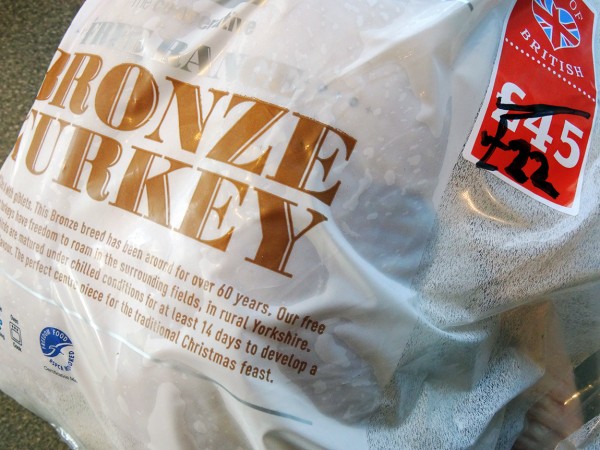 According to the supply and demand model, we would expect the price of turkeys to be high at this time of year. After all, last Christmas in the UK over 10 million turkeys were consumed and, therefore, this high level of demand should cause prices to rise. This is certainly what happens in other markets when there is a substantial increase in demand.
According to the supply and demand model, we would expect the price of turkeys to be high at this time of year. After all, last Christmas in the UK over 10 million turkeys were consumed and, therefore, this high level of demand should cause prices to rise. This is certainly what happens in other markets when there is a substantial increase in demand.
However, evidence from Thanksgiving in the USA suggests that this might not be the case. According to this article from the New York Times, data suggests that the price of frozen turkeys in the US falls by around 9% between October and November, coinciding with the substantial increase in demand for Thanksgiving celebrations. The article then goes on to suggest a number of plausible demand and supply-side explanations for this fall in price.
Turkey Economics 101: Why turkeys are so darn cheap this time of year Culinate (25/11/13)
Why Does Turkey Get Cheaper Around Thanksgiving? Slate, Matthew Yglesias (21/11/12)
Questions
- How elastic do you think the demand for turkeys will be at Christmas?
- What type of products are well suited to being used as loss-leaders?
- Which of the explanations for the increase in prices do you find most convincing?
- What evidence might be useful to distinguish between the different explanations?
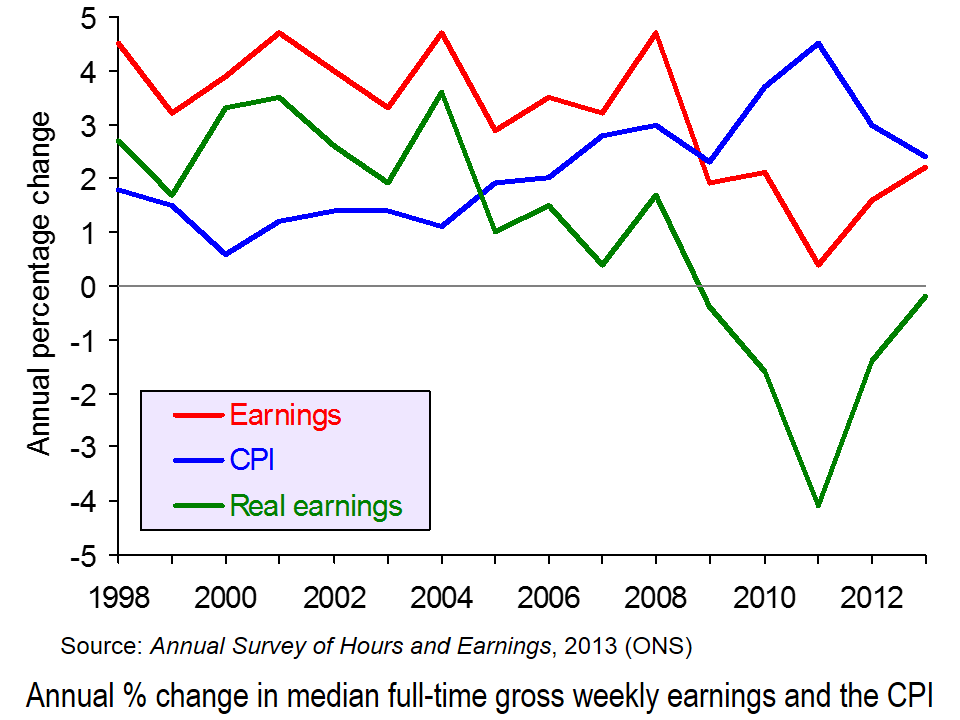 The ONS has just published two of its major annual publications on income and expenditure in the UK. The first is the Annual Survey of Hours and Earnings (ASHE) and looks at earnings from 1998 to 2013. The second is Family Spending and looks at the level and pattern of household spending each year from 2001 to 2012.
The ONS has just published two of its major annual publications on income and expenditure in the UK. The first is the Annual Survey of Hours and Earnings (ASHE) and looks at earnings from 1998 to 2013. The second is Family Spending and looks at the level and pattern of household spending each year from 2001 to 2012.
Figures from the two publications show that average real incomes have fallen each year since 2008. This is illustrated in the first chart (click here for a PowerPoint of the chart). They also show that household expenditure in real terms is falling and is at the lowest level since 2006.
Overall picture
In 2012, households’ average weekly disposable income was £597. In 2012 prices, this was down from £621 in 2010 (after the recession) and £659 in 2008 (before the recession).
Household expenditure is at its lowest level in real terms for over a decade. In 2012 households spent on average £489.00 per week. In 2012 prices, this compares with £521.90 in 2001/2 and £533.80 in 2006 (the peak year).
Picture for particular income groups and products
Although average real incomes have fallen, not everyone has been affected the same. For example, not all occupations have seen a fall in incomes (see the table at the end of the BBC article, Earnings rise slower than inflation for fifth year running). Also, as income distribution has become less equal, so those in lower income groups have seen their real incomes fall the fastest. This is partly the result of nominal wages rising less fast for low-paid workers and partly the result of price increases for various essentials, such as food and power being greater than the rate of inflation, and these products constituting a higher proportion of expenditure for poor people than rich people (see Squeezed Britain 2013).
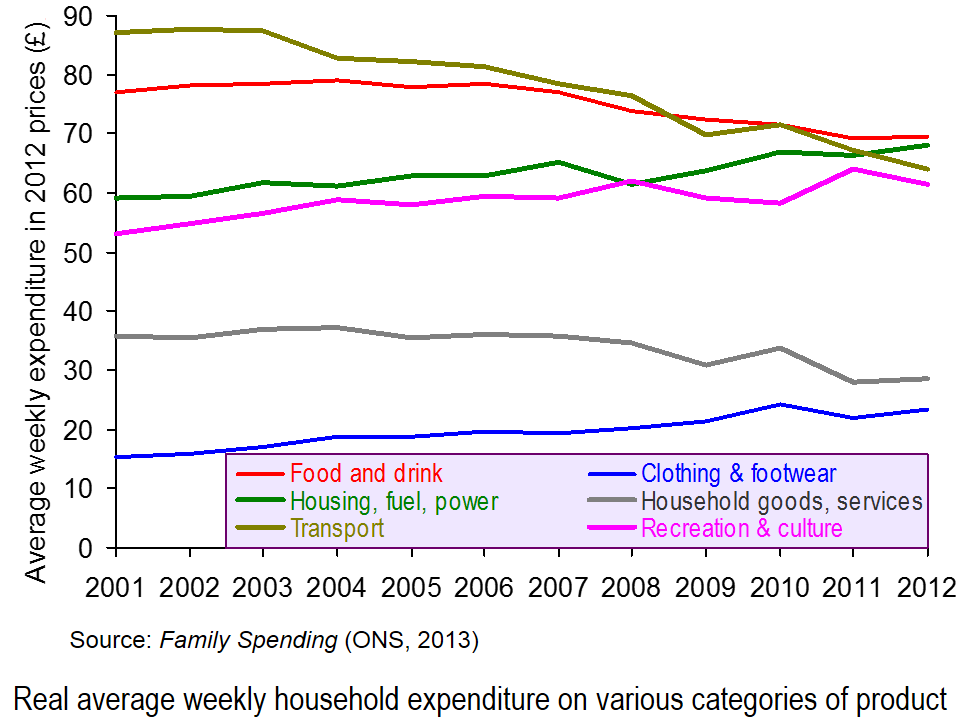 Likewise expenditure hasn’t fallen on all categories of product. Since 2006, real expenditure on clothing and footwear and on housing, fuel and power has risen. The second chart illustrates expenditure on some of the different categories and how the balance has changed (click here for a PowerPoint). This partly reflects the changes in prices of products, with some items, such as electricity, gas and rent having risen faster than the average, and with the demand for such items being relatively price inelastic.
Likewise expenditure hasn’t fallen on all categories of product. Since 2006, real expenditure on clothing and footwear and on housing, fuel and power has risen. The second chart illustrates expenditure on some of the different categories and how the balance has changed (click here for a PowerPoint). This partly reflects the changes in prices of products, with some items, such as electricity, gas and rent having risen faster than the average, and with the demand for such items being relatively price inelastic.
The changing pattern is also partly the result of different income elasticities of demand for different items. Thus, with falling real incomes, the proportion of income spent on products with a low income elasticity of demand is likely to rise.
 Expenditure also varies by income group. People on higher incomes tend to spend a greater proportion of their income on things such as leisure activities (e.g. eating out and holidays), motoring, and clothing and footwear. Poorer people tend to spend proportionately more on food and drink, and on electricity, gas and rent (even net of housing benefit). These differences are illustrated in the third chart which looks at certain categories of expenditure of three different disposable income groups: the poorest 10% (decile), the richest 10% and the 6th decile (i.e. the 6th group up from the bottom – the group with average or just above average income) (click here for a PowerPoint for the chart). Detailed figures can be found here, which is Table 3.2 from Family Spending.
Expenditure also varies by income group. People on higher incomes tend to spend a greater proportion of their income on things such as leisure activities (e.g. eating out and holidays), motoring, and clothing and footwear. Poorer people tend to spend proportionately more on food and drink, and on electricity, gas and rent (even net of housing benefit). These differences are illustrated in the third chart which looks at certain categories of expenditure of three different disposable income groups: the poorest 10% (decile), the richest 10% and the 6th decile (i.e. the 6th group up from the bottom – the group with average or just above average income) (click here for a PowerPoint for the chart). Detailed figures can be found here, which is Table 3.2 from Family Spending.
Just as the time-series data looking at changing income and expenditure over time can illustrate the different income elasticities of demand for different products, so can the cross-sectional data in Tables 3.1 and 3.2 of Family Spending.
Articles
Earnings rise slower than inflation for fifth year running BBC News (12/12/13)
Energy and rent are now the biggest family bills The Telegraph, Steve Hawkes (11/12/13)
Families spend £489 each week – on what? The Guardian, Mona Chalabi (11/12/13)
Cost of energy hits family budgets, says ONS BBC News (11/12/13)
Family spending interactive: how has it changed? The Guardian Datastore, Mona Chalabi (11/12/13)
Data
Annual Survey of Hours and Earnings, 2013 Provisional Results ONS (12/12/13)
Annual Survey of Hours and Earnings, 2013 Provisional Results: Statistical Bulletin ONS (12/12/13)
Family Spending, 2013 Edition ONS (11/12/13)
Family spending in 2012: Infographic ONS (11/12/13)
 Video Summary: Are you an average spender? ONS (11/12/13)
Video Summary: Are you an average spender? ONS (11/12/13)
Household expenditure based on COICOP classification, 2001-02 to 2012 at 2012 prices: Table 4.1 of Family Spending ONS (11/12/13)
Detailed household expenditure as a percentage of total expenditure by disposable income decile group, 2012: Table 3.2 of Family Spending ONS (11/12/13)
Questions
- What are the determinants of the price elasticity of demand for a product?
- What are the limitations of using time-series data of prices and expenditure to estimate the price elasticity of demand for particular products?
- What are the determinants of the income elasticity of demand for a product?
- What are the limitations of using time-series data of incomes and expenditure to estimate the income elasticity of demand for particular products?
- What are the limitations of using cross-sectional data of expenditure of different income groups to estimate the income elasticity of demand for particular products?
- How do your answers to the above questions demonstrate the significance of the ceteris paribus (other things being equal) assumption?
- If real earnings are falling, why are people able to spend more in real terms?
- What are the macroeconomic implications of increased consumer spending at a time of falling real incomes?
- How could increased consumer spending help to reverse the fall in real incomes (a) in the short run (b) over a period of a few years? Distinguish between the effects on aggregate demand and aggregate supply.
 Globalisation has led to an increasingly interdependent world, with companies based in one country often dependent on a market abroad. In recent years, it is the rapid growth of countries like China that has led to growth in the size of the markets for many products. With incomes rising in emerging countries, demand for many products has been growing, but in the past year, the trend for Prada has ended and seems to be reversing.
Globalisation has led to an increasingly interdependent world, with companies based in one country often dependent on a market abroad. In recent years, it is the rapid growth of countries like China that has led to growth in the size of the markets for many products. With incomes rising in emerging countries, demand for many products has been growing, but in the past year, the trend for Prada has ended and seems to be reversing. This lower growth in same-store sales is likely to continue the following year as well. Add on to this the lower-than-expected profits, which missed analysts’ forecasts, and you have a prime example of a brand that is suffering because of its customer base and the economic times.
This lower growth in same-store sales is likely to continue the following year as well. Add on to this the lower-than-expected profits, which missed analysts’ forecasts, and you have a prime example of a brand that is suffering because of its customer base and the economic times. Prada has exploited high demand by Chinese consumers, but has recently been affected by the strength of the euro. A strong euro means that the Italian-based Prada is struggling with exports, which only adds to its problems. As economic growth picks up in China and as other emerging economies begin to experience more rapid economic growth, the fortunes of this luxury-retailer may change once more. However, with volatile economic times still around in many countries, the future of many retailers selling high-end products to higher income customers will remain uncertain. The following articles consider the fortunes of Prada.
Prada has exploited high demand by Chinese consumers, but has recently been affected by the strength of the euro. A strong euro means that the Italian-based Prada is struggling with exports, which only adds to its problems. As economic growth picks up in China and as other emerging economies begin to experience more rapid economic growth, the fortunes of this luxury-retailer may change once more. However, with volatile economic times still around in many countries, the future of many retailers selling high-end products to higher income customers will remain uncertain. The following articles consider the fortunes of Prada.






